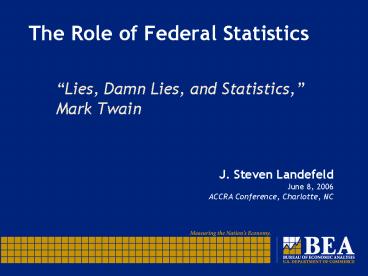The Role of Federal Statistics - PowerPoint PPT Presentation
1 / 20
Title:
The Role of Federal Statistics
Description:
ACCRA Conference, Charlotte, NC 'Lies, Damn Lies, and Statistics,' Mark Twain. 2. www.bea.gov ... Model: Correct for 19 of 23 elections (1916-2004) ... Elections ... – PowerPoint PPT presentation
Number of Views:45
Avg rating:3.0/5.0
Title: The Role of Federal Statistics
1
The Role of Federal Statistics
- Lies, Damn Lies, and Statistics, Mark Twain
J. Steven Landefeld June 8, 2006 ACCRA
Conference, Charlotte, NC
2
Uses in Budgeting
Federal
Office of Management and Budget Sensitivity of
the Budget to Economic Assumptions
State Local
- 21 states have statutory limits on revenues and
spending tied to state personal income or some of
its components - Most state agencies use BEA data for tax revenue
forecasts
Source OMB, Analytical Perspectives, p. 174.
3
Statistics, Institutions, and Stability
Source BEA, NIPA table 1.7.3 DOC, Long Term
Economic Outlook 1860-1970, Washington, DC GPO
(1973).
4
Uses in Allocating Funding
Other, 1,979
State
children's
insurance
All other,
program
Medicaid,
(CHIP), 4,725
21,359
193,198
Child care
development
block grant,
2,083
Source General Services Administration
Catalog of Federal Domestic Assistance, April
2006.
5
BEA Data ? Regional Accounts
- Gross State Product, and State and Local area
personal income used in - Market research
- Forecasting public service needs
- Energy and water use modeling
- Environmental impact statement
- Regional Input-Output Modeling System (RIMS)is
used to estimate the regional economic impacts - Opening/closing military bases
- Tourist expenditures
- New energy facilities
- Construction of sports facilities, airports, or
ports
6
Why Does It Matter? ? Elections
- Ray Fair Model Correct for 19 of 23 elections
(1916-2004) - V one partys share of the two-party
presidential vote - I, DPER, and DUR variables used to describe
incumbent party, if an incumbent is running, and
the duration that a party has been in power - g3 real per capita GDP annual growth rate for
first 3 qtrs. of the election yr. - p15 abs. value of GDP deflator annual growth
rate for the first 15 qtrs. of the administration - n of qtrs. in the first 15 qtrs. of the
administration in which real per capita GDP
annual growth rate is greater than 3.2
Note Formula excludes sections that drop out
when not in a major war (election years 1920,
1944, and 1948).
7
Why Does It Matter? ? Elections
- Its the economy stupid. Bill Clinton
8
What the Statistics Tell Us ? Offshoring
U.S. Parent Share of MNC Employment
U.S. Parent Share of MNC Value Added
75
Source BEA foreign direct investment data.
9
What the Statistics Tell Us ? Offshoring
Destination of Sales by Foreign Affiliates
High-Wage-Country Share of Affiliate Employment
66
Source BEA foreign direct investment data.
10
Domestic Movement of Output
Source BEA.
11
What the Statistics Tell Us ?Are You Better Off
Today?
Source Bureau of Labor Statistics CES data
BEA, NIPA table 2.1 and 2.3.4.
12
Alternative Measures of Income
State Personal Income (SPI) Census Money
Income, 2001
U.S. personal income 8.678 trillion Census
U.S. money income 6.446 trillion
- SPI includes
- Property income of pension assets
- Employer contributions for pensions and insurance
- Transfer payments such as Medicare, Medicaid
- Imputed interest, other income of NPISHs, net
rental income of owner occupied housing - Adjustments for understatement of income
13
Domestic Movement of Output
Source BEA.
14
Wage Salary Employment Growthby MSA, 2001-2004
2006
2007
Declining wage salary employment
Increasing wage salary employment Non-MSA
14
15
Contact Information
16
Accelerations
17
Other Improvements
18
What the Statistics Tell Us ? Poverty
Source Bureau of the Census Author Dale W.
Jorgenson, Did We Lose the War on Poverty? JEP,
Winter 1998.
19
What the Statistics Tell Us ? Are You Better Off
Today?
Source IMF, World Economic Outlook Database,
Sept. 2005.
20
What the Statistics Tell Us ? Are You Better Off
Today?
Source IMF, World Economic Outlook Database,
Sept. 2005.































